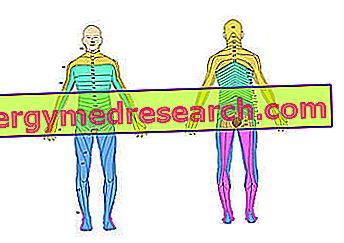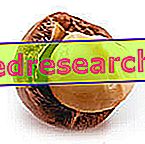What is the Seitan?
Seitan is a food product derived from wheat; it is, in particular, a concentrate of vegetable proteins (gluten), an alternative to traditional protein sources of animal origin.
Not by chance, the name seitan - coined by the macrobiotic George Oshawa in 1961 - translated from Japanese means " is protein ".

Preparation
Also called " wheat meat " (or gluten meat), seitan is obtained by extracting gluten from wheat flour (preferably from semolina), then - according to the traditional recipe - mixing and boiling in water, seasoned with sauce soy, kombu seaweed, ginger and salt.
Gluten extraction for seitan
The process of extracting gluten from wheat is carried out by adding hot water to the flour, then kneading vigorously before adding further hot water, in which the dough will be left to rest, in a bath, for about ten minutes.
After a new and energetic mixture, the resulting mass is placed in a colander and subjected to washing cycles in hot and cold water, to remove the remaining water-soluble components. The last wash should be done with cold water, in order to give a solid consistency to the product and compact it into a large ball.
The amount of gluten that is obtained is greater when using durum wheat flour (otherwise called semolina); in general, as the strength of the flour increases, the concentration of the gliadins and glutenins also increases, two proteins that - joining together during the dough - make up the gluten.
Note : the soaking water and that of the first rinses, rich in wheat starch, can be recovered and added to stews or ragù due to its thickening properties.
Video Recipe
Homemade Seitan
Directly from the vegan recipes section, we offer the video recipe to learn how to make seitan at home .
Homemade Seitan
X Problems with video playback? Reload from YouTube Go to Video Page Go to Video Recipes Section Watch the video on youtubeFor those who buy ready-made seitan, we suggest the video-recipes of homemade seitan ragù, vegan chickpea crepes with seitan ragout and vegan fillet with green pepper.
Also not to be missed are the video recipes on homemade wheat muscle and mopur, two alternative vegetable meats to seitan.
Organoleptic characteristics
The appearance of the seitan lends itself very well to creating imitations of the flesh ; the gluten mixture can in fact be worked to give it the form of sausages, steaks, cuts for stews and so on, while the skilful use of spices can give the product more delicate or decisive flavors.
Very fast to cook, given the precooking necessary to produce it, the seitan is generally cooked on the griddle, paying attention to the cooking temperature to avoid the formation of the characteristic burns on the surface, rich in not exactly healthy substances, which would nullify the supposed nutritional virtues of seitan.
This resemblance to meat is due to the presence of two gluten proteins, gliadins and glutenins, which give the product an elastic, soft but resistant consistency . Even the flavor of the seitan is more delicate than the carna, while the nutritional power is much lower.

Nutritional Properties
Seitan proteins and digestibility
Except for mild or consistent gluten intolerances (celiac disease), in theory the seitan is easily digestible and absorbable; however it is deficient in lysine, which not by chance represents the limiting amino acid of wheat. Furthermore, it is likely that the digestibility of the product is not that high, given that the seitan has obtained a very low score in the new protein quality index developed by the WHO, the PDCAAS (Protein Digestibility Corrected Amino Acid Score or amino acid value corrected for protein digestibility).
Lysine deficiencies can be easily filled by other protein sources, both vegetable and animal, consumed at the same meal or in the previous and subsequent ones (legumes, eggs, cheeses and meat foods). Therefore, even the addition of soy sauce (obviously in large quantities) or even better of tofu, can fill the amino acid deficiencies and enrich the lipid component, which is fundamental for the good health of the organism (despite the high calorific value).
Seitan is a discrete alternative protein source, useful not only for vegetarians, but also for all those who need to reduce the food content of protein and animal fats. In this regard, we recall that according to the guidelines for a healthy Italian diet, the ratio between animal and vegetable proteins in the diet should be around values between 1: 2 and 1: 3.
As for vegetarians, food cannot obviously be based on the exclusive consumption of seitan as an alternative protein source, given the lack of lysine and the incomplete biological value.
Vitamin and mineral deficiencies of seitan
Vitamin B12 and iron are also scarce in seitan, often already lacking in vegan nutrition; B12, in fact, is found only in meat foods (that of algae is poorly bioavailable) and iron - in addition to lower bioavailability, given its presence in ferrous rather than ferric form - is complexed to antinutrients such as phytic acid.
Other nutritional characteristics of seitans
Seitan can be evaluated in two forms: dehydrated or ready; below we will examine the second alternative.
The seitan has a medium energy supply; calories are mainly supplied by proteins, followed by starch and irrelevant amounts of fat.
It does not contain cholesterol and the fibers are present in small quantities.
Among the vitamins, the quantities of some water-soluble of group B (thiamine and niacin) are more appreciable; with regard to mineral salts, the concentration of potassium and magnesium is appreciable.
Seitan is not suitable for eating celiac disease, but has no contraindications for nutritional regimens intended for other intolerances.
It also lends itself to the diet for overweight and metabolic diseases, as long as the portion and the recipe in question are adequate.
Respect the canons of the vegetarian and vegan diet.
The average portion of ready seitan (hydrated) is about 100-200 g.
Seitan: Does it hurt?
Seitan is "almost" pure gluten . This is why the reasons for a possible side effect of food on the body are probably due to this nutrient.
Recently, gluten has been the subject of numerous controversies and controversies. Being potentially responsible for celiac disease, in subjects predisposed to this food intolerance, gluten has long been in the eye of the storm.
Health-conscious, physical experts and those suffering from so-called idiopathic disorders (such as the irritable bowel) have found gluten an excellent scapegoat. Consequently, some CONJECTURES are very common, such as:
- Gluten (contained in some cereals available thanks to agriculture) is not well tolerated by the human digestive system, which has developed thanks to the collection attitude (vegetables, fruit, eggs) and hunting (small animals) typical of our ancestors
- Gluten inflames the body, not only in the intestine, but also at a systemic level, hindering proper metabolic functioning; this negative effect would cause: autoimmune diseases such as psoriasis, water retention, cellulite, weight loss obstacle etc.
- We are all intolerant to gluten which is why the most sensitive people, even if they do not show the typical effects of celiac disease, suffer from intestinal disorders commonly referred to irritable bowel syndrome, etc.
If we consider that 86% of the calories supplied by the seitan (ready) is gluten, it is easy to deduce how much this food can be demonized.
However, it must be admitted that a large slice of the population, after eating gluten-containing foods and despite being negative for the diagnosis of celiac disease, complains of a well-defined symptom picture.
Auto-suggestion? Partly yes, but given the importance of the incidence, we cannot take anything for granted. For this reason we are hypothesizing that, in addition to a sort of collective hallucination, there is a specific sensitivity to non-celiac gluten .
According to the most recent data, these discomforts would not have the same harmful effects on the intestinal mucosa (typical of celiac disease), despite being characterized by the same markers in the blood.
Unfortunately, at the end of this paragraph we are still not able to answer with precision the question "does the seitan hurt?" . On the other hand, we can still report some useful tips:
- If by eating seitan specific and serious symptoms appear, it is good practice to begin the diagnostic procedure for celiac disease
- We must not allow ourselves to be influenced by the opinion of others; since gluten intolerance should trigger adverse reactions, before defining oneself as intolerant, it is essential to look for these symptoms and clinical signs
- We do not blame the seitan of our unsatisfactory appearance, autoimmune diseases or idiopathic ones; rather, we try to exclude one food at a time by identifying "if" and "how" food is involved in these situations.



